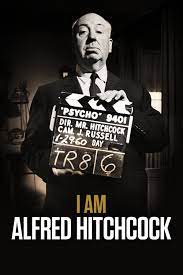
I AM ALFRED HITCHCOCK
US, 2021, 90 minutes, Colour.
Directed by Joel Ashton O’Reilly.
This is one of the later entries in the television series starting, I Am… Since 2011, a variety of subjects have been chosen ranging from Bruce Lee to Martin Luther King Jr to Steve McQueen to Usain Bolt. They have been produced by Derik Murray. They offer the opportunity to go back over the career of their subject, providing a portrait, built up by footage of their lives, footage of their films, and a range of talking heads. In this case, there are no talking heads. Rather, a range of actors from Hitchcock’s films, from his granddaughter, from many celebrated directors who admire Hitchcock, make their comments but they are played underneath photos or clips from the films.
(And this is a help for viewers because, while all Hitchcock’s titles are shown in a frame, we are all disappointed that so many favourites do not have any clips included – The Lady Vanishes, Spellbound, Notorious, Dial M for Murder, The Wrong Man… However, there is a very good overview of Hitchcock’s work in the British industry of the 1920s (though no mention of his going to work in Germany). A great deal is made of his relationship, very difficult, with David O.Selznick and the making of Rebecca. And there are sequences from Hitchcock’s favourite, Shadow of the Doubt.
There is attention to Rope, disappointment with the response to Under Capricorn because of the scandal concerning Ingrid Bergman and Roberto Rossellini at the time. Also attention given to Rear Window, even more attention to Vertigo, a glimpse of North by Northwest.
But, the centre of attention is on Psycho. There are explanations about the origins of the story, Robert Bloch’s novel, warnings to Hitchcock that it would be unwise to make the film, talk about the small budget, working with Janet Leigh, the 45 seconds of the shower sequence and explanations of how it was made and edited. There are scenes of queues around blocks to see the film, and see it again, success despite Hitchcock’s apprehensiveness. There is a great deal of discussion about the influence of Psycho, of thriller storytelling, of expert marketing, of the influence on thrillers and slasher films to come.
Concerning after-Psycho, there are images from The Birds, Marnie – and time devoted to reflection on Hitchcock and his infatuation with the blondes. There is Joan Harrison who was his assistant and marketer, returning to work with him on his television series. There is Madeline Carroll and glimpses from The 39 Steps, Kim Novak, of course Grace Kelly, and some background to his choice of Tippy Hedren and his harsh treatment of her, setting actual birds on her during filming.
Some of these themes of take been taken up in feature films, the making of psycho with Anthony Hopkins as Hitchcock and Helen Mirren as his long-time wife and collaborator, Alma Reville. There was also The Girl, with Toby Jones as Hitchcock and Sienna Miller as delete Tippy Hedren.
And the documentary gives a great deal of attention to the development of the television series but, more, to Hitchcock’s own self-publicity in the introductions, his enjoyment of raising expectations in trailers of films, especially for Psycho, the pofaced joking situations in which he presents himself. Which means that, with his inclusion of his cameo in most of his films, and these introductions, audiences were well aware of him as a Director, perhaps more so than any other Director.
He slowed down although there is some attention to his 1972 Frenzy with him working back in London. He never won an Oscar but received several awards, honorary Oscar, and an AFI Lifetime award which made him very happy and was the occasion of many of the stars to share the occasion with him, Cary Grant next to him, Ingrid Bergman making the speech, and his decision to thank only four people who had had an impact in his life – and they were all Alma Reville.
The value of these portraits in the I am series is that they do provide a lot of information as well as a great deal of footage on their subject – and the desire on the part of the audience to see and know more.